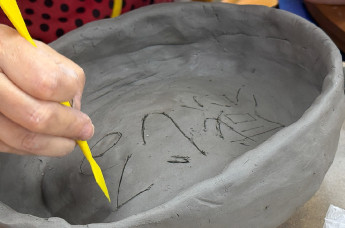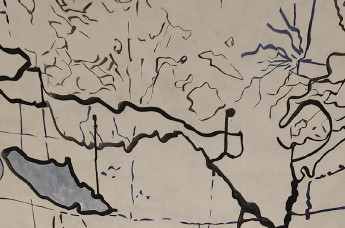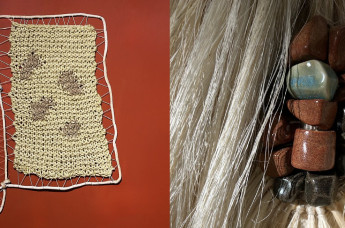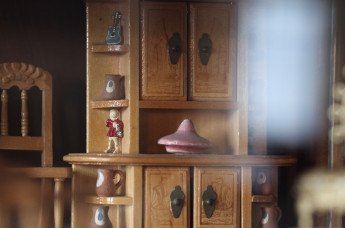BIENALSUR returns to Saudi Arabia with an interactive and poetic exhibition devoted to new ways of experiencing reality. With the participation of more than 20 artists from Africa, America, Asia and Europe
The International Biennial of Contemporary Art of the South organized by the National University of Tres de Febrero (UNTREF) arrives for a second time in Saudi Arabia to present the group exhibition Echoes. A World between the Analogue and the Virtual, with the participation of more than 20 artists from Africa, America, Asia and Europe. The exhibition opens on Friday, October 15th, at the JAX District of Riyadh and on Tuesday, November 30, at the Qasr Khuzam in Jeddah, with the support of the Ministry of Culture of Saudi Arabia.
Curated by BIENALSUR’s Artistic Director Diana Wechsler, the proposal brings together the productions of Ahaad Alamoudi (SAU), Darren Almond (GBR), Daniah Alsaleh (SAU), Joël Andrianomearisoa (MDG), Hugo Aveta (ARG), Cécile Bart (FRA), Daniel Canogar (ESP), Tanja Deman (CRO), Sève Favre (CHE), Lina Gazzaz (SAU), Gabriela Golder (ARG), Valérie Jouve (FRA), Chris Larson (USA), Anaïs Lelièvre (FRA), Sujin Lim (KOR), Rafael Lozano-Hemmer (MEX), Matilde Marin (ARG), Angelika Markul (POL), Filwa Nazer (SAU), Tony Oursler (USA), Muhannad Shono (SAU) and Carola Zech (ARG).
Under the curatorial axis Modes of Inhabiting / Fluid Constellations, the exhibition takes the acoustic phenomena of echo and reverberation as poetic metaphors for the ways in which we naturally move in the world between analog and virtual situations.
The exhibition is characterized not only by the diversity of cultures and nationalities represented in the different artists who participate, but that heterogeneity is also reflected in the expressive media and formats chosen by them, which include a wide range of installations, interactive objects, video installations, and photographs.
The relativization of space is the theme that runs through the works of Joël Andrianomearisoa, Cécile Bart, Daniel Canogar, Anaïs Lelièvre, Rafael Lozano-Hemmer, Muhannad Shono and Carola Zech, who find a perfect counterpoint in those of Darren Almond and Hugo Aveta, where time is also relativized.
Memory, history and the inclusion of past and present imaginaries are revealed to the public in the video installations of Tanja Deman, Gabriela Golder, Chris Larson, Matilde Marin, Angelika Markul and Sujin Lim, in the photographs of Valérie Jouve and in the interactive objects of Sève Favre. Like a coda, the condition of the subject is portrayed in the works of Daniah Alsaleh and Tony Oursler.
In the JAX District of Riyadh, Km 12843 of BIENALSUR, the exhibition will be open for visitation until November 15, while in the Qasr Khuzam of Jeddah, KM 12009 of BIENALSUR, it will run until December 30.
The third edition of BIENALSUR takes place from July to December in more than 120 venues in 50 cities in 23 countries, with the participation of more than 400 artists. It works as a network of associative collaborations between museums, cultural centers and universities around the world, beginning at the South of the South as an exercise of indiscipline. It calls to rethink what has been instituted, seeking to contribute to the emergence of new logics of artistic and social circulation on a local and a global scale. BIENALSUR builds its own cartography, which opens up to the five continents, highlighting the value of the local in the global, the uniqueness in diversity, and the defense of the right to culture.
For Anibal Jozami, UNTREF’s Rector and General Director of BIENALSUR, horizontality is one of the most important features of this Biennial.
“It links artists, curators and various social groups of different origins and trajectories under equal conditions in the same way, thus building new circuits of exchange that only take place within the framework of this project. Being it the first in using this methodology, it includes works and curatorial projects that are the result of an International Open Call, along with invitations to artists and works from collections of different origins. This unique curatorial strategy translates into exhibitions, interventions in museum collections and interventions in public spaces that respond to the particularities of each associated institution, while promoting, through its curatorial axes, an international conversation on the most urgent issues of our time”, he expressed.
In this sense, Jozami foregrounded that BIENALSUR is a space for permanent dialogue and that the participation of artists from various origins in Saudi Arabia is part of a situation of necessary, vital and auspicious cultural exchange.
Photo: THorizon, Tanja Deman (2021)




